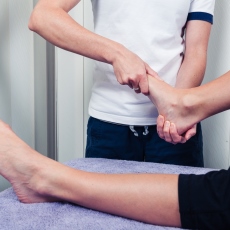

05/25/2017 11:11 AM EDT
Fuente: Merck Sharp & Dohme de España
Páginas relacionadas en MedlinePlus: Distonía
Páginas relacionadas en MedlinePlus: Distonía
05/25/2017 11:11 AM EDT
Fuente: Academia Americana de Médicos de Familia
Páginas relacionadas en MedlinePlus: Distonía


Páginas relacionadas en MedlinePlus: Distonía
Institutos Nacionales de la Salud
Distonía
La distonía es un trastorno del movimiento que causa contracciones involuntarias de los músculos. Estas contracciones resultan en torsiones y movimientos repetitivos. Algunas veces son dolorosas.
La distonía puede afectar solamente un músculo, un grupo de músculos o todos los músculos. Los síntomas pueden incluir temblores, problemas en la voz o arrastrar un pie. Los síntomas suelen comenzar en la infancia. También pueden comenzar al final de la adolescencia o en la edad adulta temprana. Algunos casos empeoran con el tiempo. Otros son leves.
Algunas personas heredan esta condición. Otras, la desarrollan como consecuencia de otra enfermedad. Los investigadores consideran que la distonía proviene de un problema en la parte del cerebro que controla los mensajes relacionados con las contracciones musculares. No existe una cura. Pero los médicos usan medicinas, inyecciones de Botox, cirugía, terapia física y otros tratamientos para reducir o eliminar los espasmos musculares y el dolor.
NIH: Instituto Nacional de Trastornos Neurológicos y Accidentes Cerebrovasculares
- Inyección de toxina botulínica para la laringe (Enciclopedia Médica)También en inglés
- Inyecciones de toxina botulínica: Un tratamiento para espasmos musculares(Academia Americana de Médicos de Familia)También en inglés
- Disfonía espasmódica (Enciclopedia Médica)También en inglés
 Distonía cervical (Academia Americana de Médicos de Familia)
Distonía cervical (Academia Americana de Médicos de Familia)- Síndrome de Leigh
 (Centro de Información sobre Enfermedades Genéticas y Raras)
(Centro de Información sobre Enfermedades Genéticas y Raras) - Tortícolis (Enciclopedia Médica)También en inglés
- Tortícolis (Fundación Nemours)

Dystonia

MEDICAL ENCYCLOPEDIA
National Institutes of Health
Dystonia is a movement disorder that causes involuntary contractions of your muscles. These contractions result in twisting and repetitive movements. Sometimes they are painful.
Dystonia can affect just one muscle, a group of muscles or all of your muscles. Symptoms can include tremors, voice problems or a dragging foot. Symptoms often start in childhood. They can also start in the late teens or early adulthood. Some cases worsen over time. Others are mild.
Some people inherit dystonia. Others have it because of another disease. Researchers think that dystonia may be due to a problem in the part of the brain that handles messages about muscle contractions. There is no cure. Doctors use medicines, Botox injections, surgery, physical therapy, and other treatments to reduce or eliminate muscle spasms and pain.
NIH: National Institute of Neurological Disorders and Stroke
- Symptoms and Diagnosis (Dystonia Medical Research Foundation)
- Botulinum Toxin Injections: A Treatment for Muscle Spasms(American Academy of Family Physicians)Also in Spanish
- Dystonia: Emotional and Mental Health (Dystonia Medical Research Foundation)
- Dystonia: Physical Therapy (Dystonia Medical Research Foundation)
- Dystonia: Related and Differential Disorders (Dystonia Medical Research Foundation)
- Employees with Dystonia (Office of Disability Employment Policy)
- Traumatic Brain Injury and Dystonia (Dystonia Medical Research Foundation) - PDF
- Cervical Dystonia (Spasmodic Torticollis) (Mayo Foundation for Medical Education and Research)
- Forms of Dystonia (Dystonia Medical Research Foundation)
- Musician's Dystonia (Dystonia Medical Research Foundation) - PDF
- Genetics Home Reference: deafness-dystonia-optic neuronopathy syndrome
 (National Library of Medicine)
(National Library of Medicine) - Genetics Home Reference: dopa-responsive dystonia
 (National Library of Medicine)
(National Library of Medicine) - Genetics Home Reference: dopamine transporter deficiency syndrome
 (National Library of Medicine)
(National Library of Medicine) - Genetics Home Reference: dystonia 6
 (National Library of Medicine)
(National Library of Medicine) - Genetics Home Reference: early-onset primary dystonia
 (National Library of Medicine)
(National Library of Medicine) - Genetics Home Reference: GM1 gangliosidosis
 (National Library of Medicine)
(National Library of Medicine) - Genetics Home Reference: hypermanganesemia with dystonia, polycythemia, and cirrhosis
 (National Library of Medicine)
(National Library of Medicine) - Genetics Home Reference: Leigh syndrome
 (National Library of Medicine)
(National Library of Medicine) - Genetics Home Reference: MEGDEL syndrome
 (National Library of Medicine)
(National Library of Medicine) - Genetics Home Reference: myoclonus-dystonia
 (National Library of Medicine)
(National Library of Medicine) - Genetics Home Reference: Partington syndrome
 (National Library of Medicine)
(National Library of Medicine) - Genetics Home Reference: rapid-onset dystonia parkinsonism
 (National Library of Medicine)
(National Library of Medicine) - Genetics Home Reference: sepiapterin reductase deficiency
 (National Library of Medicine)
(National Library of Medicine) - Genetics Home Reference: task-specific focal dystonia
 (National Library of Medicine)
(National Library of Medicine) - Genetics Home Reference: tyrosine hydroxylase deficiency
 (National Library of Medicine)
(National Library of Medicine) - Genetics Home Reference: Woodhouse-Sakati syndrome
 (National Library of Medicine)
(National Library of Medicine) - Genetics Home Reference: X-linked dystonia-parkinsonism
 (National Library of Medicine)
(National Library of Medicine)
- Dystonia
 (National Institute of Neurological Disorders and Stroke)
(National Institute of Neurological Disorders and Stroke)
- ClinicalTrials.gov: Dystonia
 (National Institutes of Health)
(National Institutes of Health) - ClinicalTrials.gov: Torticollis
 (National Institutes of Health)
(National Institutes of Health)
- Find a Neurologist (American Academy of Neurology)
- National Institute of Neurological Disorders and Stroke
 Also in Spanish
Also in Spanish
- Botulinum toxin injection - larynx (Medical Encyclopedia)Also in Spanish
- Spasmodic dysphonia (Medical Encyclopedia)Also in Spanish
- Torticollis (Medical Encyclopedia)Also in Spanish




























.png)









No hay comentarios:
Publicar un comentario